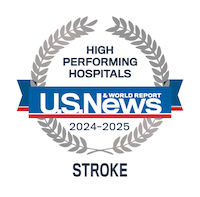Rapid Stroke Treatment
Virtual Visits Available
Virtual Health enables you to speak with providers using your phone, tablet or computer. Call 888-4GW-DOCS to schedule a virtual appointment.
 A stroke occurs when a blockage in an artery prevents blood from reaching cells in the brain or an artery ruptures inside/outside the brain, causing a hemorrhage. Each year more than 795,000 Americans suffer a stroke, causing one out of every 20 deaths in this country, according to the Centers for Disease Control and Prevention. Not only is stroke the fifth-leading cause of death in the U.S., it is also the leading cause of adult disability. Stroke should be treated with the same urgency as a heart attack.
A stroke occurs when a blockage in an artery prevents blood from reaching cells in the brain or an artery ruptures inside/outside the brain, causing a hemorrhage. Each year more than 795,000 Americans suffer a stroke, causing one out of every 20 deaths in this country, according to the Centers for Disease Control and Prevention. Not only is stroke the fifth-leading cause of death in the U.S., it is also the leading cause of adult disability. Stroke should be treated with the same urgency as a heart attack.
 Stroke Risk Assessment
Stroke Risk Assessment
Are you at risk for a stroke? This health assessment can help determine how likely you are to have a stroke in the future.
Schedule an appointment
Please fill out our general appointment form below or call our referral service at 888-4GW-DOCS.
Treating Stroke at GW Hospital
Medical professionals at the Comprehensive Stroke Center at GW Hospital provide fast and efficient stroke care to help patients reach a better outcome after suffering a stroke emergency. They are recognized as leaders in stroke care through their efforts in promoting stroke prevention and practicing quality stroke treatment.
Learn more about the Neurosciences Institute at GW Hospital →
In addition, the Acute Rehabilitation Team at GW Hospital offers stroke rehabilitation services to help patients on their path to recovery after a stroke.
Ischemic stroke
Ischemic strokes account for 80 percent of all strokes suffered. They are caused when blood vessels become clogged. Some ischemic strokes are preceded by stroke-like symptoms called transient ischemic attacks (TIAs) that can occur months before the stroke. Also called a warning stroke, a TIA is caused by a temporary blockage of a blood vessel. TIA symptoms, which are similar to those of a stroke, come on quickly and improve within 10 to 20 minutes. The loss of vision in a TIA may be described as a feeling that a shade is being pulled down over your eyes. TIAs typically do not cause long-lasting damage to the brain.
The clot-dissolving medicine called tissue Plasminogen Activator (tPA/TNK) is the drug of choice for ischemic stroke. If an ischemic stroke is diagnosed within three hours of the start of symptoms, the administration of tPA/TNK intravenously can increase a patient's chances of survival and recovery. Knowing stroke warning signs and getting to a hospital quickly is critical for tPA/TNK treatment to be successful.
If a tPA/TNK infusion does not work, tPA/TNK and other clot dissolving agents can be delivered directly to the area of blockage using an angiogram. During this process, a catheter and X-ray guidance are used to take images of the blood vessels in the neck and brain. The blockage can also potentially be removed with fine-grasping instruments or the blocked vessel can be re-opened with stents.
First in The District with RAPID CT Perfusion Software
The RAPID CT Perfusion software is a class of automated brain imaging software that enables doctors to quickly visualize reductions in blood flow to the brain and early signs of brain injury. GW Hospital was the first in the district to utilize this AI software to assist in stroke care delivery.
Stroke Volumes and Performance
2023 Stroke Volumes
| Patient Type | # of Admissions |
|---|---|
| Ischemic Stroke | 365 |
| Intracerebral Hemorrhage | 75 |
| Subarachnoid Hemorrhage (all etiologies) | 24 |
| TOTAL | 464 |
2023 GW Hospital Performance Measures AHA/ASA Get With the Guidelines
| Stroke Performance Measures | Compliance Rate * |
|---|---|
| Venous Thromboembolism Prophylaxis | 99% |
| Discharge on Antithrombotic Therapy | 100% |
| Anticoagulant Therapy at Discharge for Afib | 100% |
| IV Thrombolytic Given Within 3 hours of Last Known Well for Acute Stroke for those who arrive to the hospital within 2 hours of Last Known Well | 97% |
| Antithrombotic Prescribed by Hospital Day 2 | 96% |
| Statin Prescribed at Discharge | 100% |
| Stroke Education | 99% |
| Assessed for Rehabilitation | 100% |
* National Target Benchmark is above 90% Compliance. Data per AHA Get With the Guidelines.
2023 GW Hospital Stroke Outcomes
| Overall Complication Rate (Stroke or Death): Carotid Endarterectomy (CEA), Carotid Artery Angioplasty with Stenting (CAS), and Transcarotid Artery Revascularization (TCAR) | 0% |
|---|
Hemorrhagic stroke
Fewer strokes are categorized as hemorrhagic, which occur when weakened blood vessels inside the brain rupture (such as a tangle of defective blood vessels and capillaries called arteriovenous malformations (AVMs) or when an aneurysm (a thin spot on an artery wall) at the base of the brain bursts. Every year, an estimated 30,000 people in the United States experience a ruptured cerebral aneurysm according to the American Association of Neurological Surgeons.
Symptoms more specific to hemorrhagic stroke include headache, nausea and vomiting, neck stiffness, seizures, sudden changes in mental state and lethargy. Hemorrhagic strokes usually occur in the daytime and during physical activity. The symptoms typically begin very suddenly and evolve over several hours.
Initial treatment of a hemorrhagic stroke is difficult. Efforts are made to control bleeding, reduce pressure in the brain and stabilize vital signs, especially blood pressure. There are few medications available to treat hemorrhagic stroke. The Comprehensive Stroke Center at GW Hospital offers hemorrhagic stroke patients with options including surgery, endovascular treatment and diagnostic neuroangiography.
Stroke Symptoms
If someone is experiencing these symptoms, call 911 immediately or go to the nearest emergency room.
It's important to BE FAST if someone is having a stroke. Look for these signs:
B = Balance – Is the person suddenly having trouble with balance or coordination?
E = Eyes – Is the person experiencing sudden onset blurred or double vision or a sudden loss of vision in one or both eyes?
F = Face Drooping – Does one side of the face droop or is it numb? Ask the person to smile. Is the person's smile uneven?
A = Arm Weakness – Is one arm weak or numb? Ask the person to raise both arms. Does one arm drift downward?
S = Speech Difficulty – Is speech slurred?
T = Time to call 911 – Stroke is an emergency. Every minute counts. Call 911 immediately. Note the time when any of the symptoms first appear.
Surgical Treatment
Surgery can be used if a large amount of bleeding has occurred and the patient is rapidly getting worse. Depending on the location of the aneurysm and a patient's condition following the stroke, surgery may not be an option. Surgery can involve clipping the aneurysm, surgical resection of AVMs and carotid endarterectomies.
- Surgical clipping – Treats an aneurysm by placing a clip across its neck or origin to prevent filling of the aneurysm.
- Surgical resection of AVMs – Prevents further bleeding by removing the tangle of defective blood vessels and capillaries.
- Carotid endarterectomy – Opens a carotid artery blockage and cleans out the debris narrowing of the vessel.
Endovascular Treatment
Another option is sealing the aneurysm with coils delivered through the angiogram technique. This is the less invasive option, but is not yet suitable for all aneurysms. Methods include:
- Endovascular coiling – Treats an aneurysm by packing the weakened area of the ballooning vessel with small coils that fill the space and prevent bleeding.
- Endovascular embolization of AVM – Injects a small amount of glue-like material that seals off the abnormal connection between vessels.
- Endovascular stenting of carotid artery occlusions – Uses a metal mesh tube to re-establish normal blood flow to the brain and is deployed through a catheter.
Diagnostic Neuroangiography
An advanced imaging technique where an interventional radiologist accesses neck and brain vessels through an artery in the groin. This diagnostic technique allows precise mapping of brain arteries and problem areas.
Awards and Accreditation
 Get With The Guidelines® - Stroke Gold Plus and Target: Stroke Elite Plus Honor Roll Award (2024)
Get With The Guidelines® - Stroke Gold Plus and Target: Stroke Elite Plus Honor Roll Award (2024)
This award from the American Heart Association®/American Stroke Association® recognizes the hospital for its commitment to ensuring stroke patients receive the most appropriate treatment according to nationally recognized, research-based guidelines, ultimately leading to more lives saved and reduced disability.
U.S. News & World Report High Performing Hospital for Stroke (2024-25)
Hospital for Stroke (2024-25)
This award recognizes GW Hospital's commitment to a higher standard of care for stroke. Hospitals that earned a high performing rating from U.S. News & World Report were significantly better than the national average.
#1 in the South by Newsweek
The GW Hospital Acute Rehabilitation Program was ranked #1 in the South by Newsweek for 2024 for it's standout Stroke program. The Stroke program has received this honor the past three years in a row, and climbed up the ladder to the #1 spot in the South.
Additional Resources
Podcast: Stroke Care: Treatment and Technology Update
Dimitri Sigounas, MD, discusses the new technologies surrounding stroke recognition and treatment, including the future development of portable devices that could assess stroke type and severity before the patient even arrives at the hospital.

